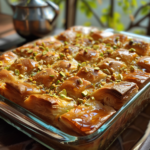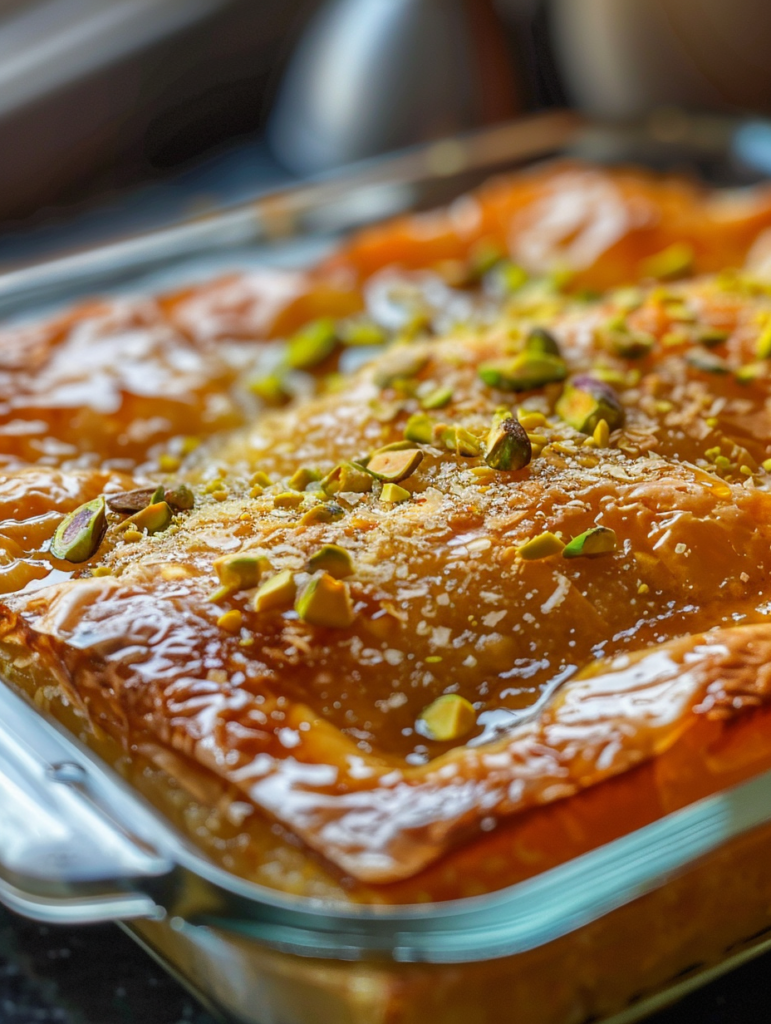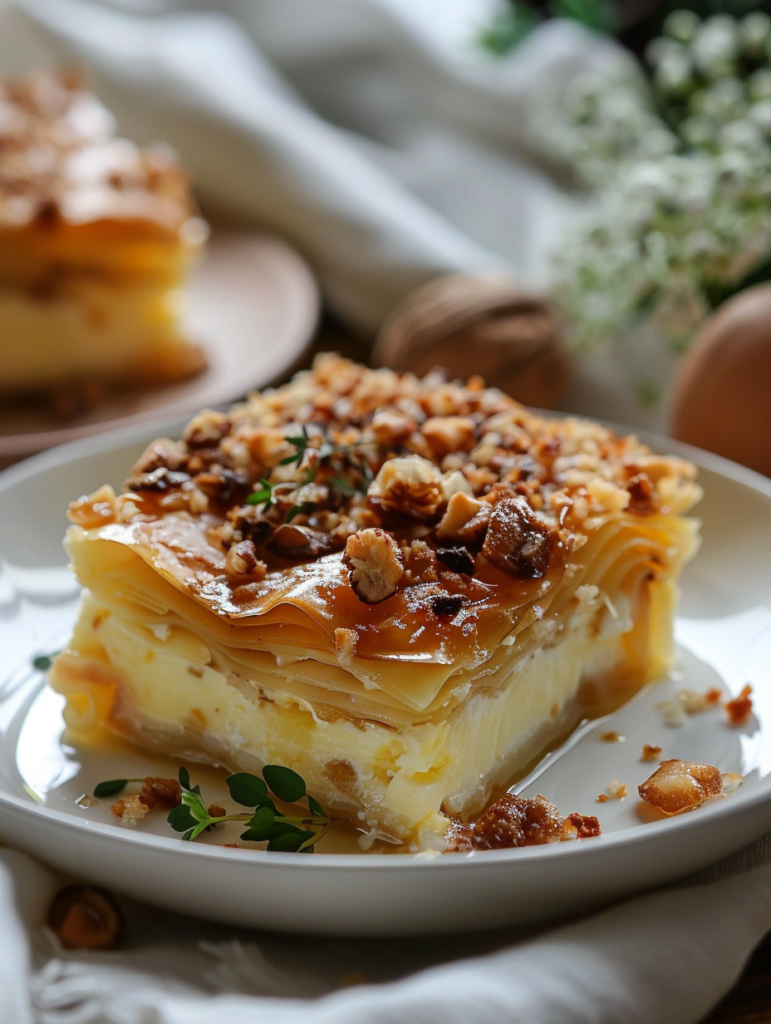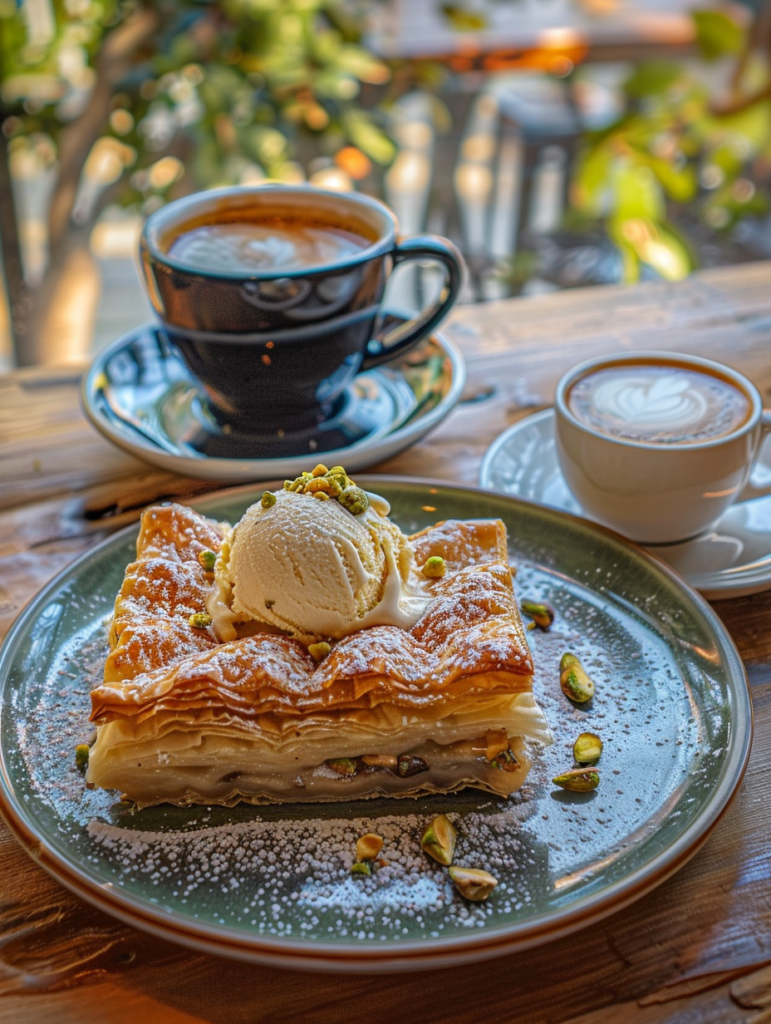Introduction
Baklava Bread Pudding is the ultimate comfort-meets-culture dessert fusion that transforms classic recipes into something unforgettable. Combining the flaky, syrup-soaked layers of Middle Eastern baklava with the creamy, custardy base of traditional bread pudding, this dish is a rich, flavorful masterpiece that delivers on both texture and taste.
If you’re a dessert lover looking for something unique, this hybrid recipe will blow your mind. Whether you’re hosting a holiday dinner or craving something cozy for a weekend treat, baklava bread pudding brings together the best of two dessert worlds. In this in-depth guide, you’ll learn how to make it step by step, master texture balance, play with bold flavor variations, and even understand how it compares to other popular desserts like molten chocolate cake.
Love rich, indulgent sweets? Try our Perfect Chocolate Lava Cakes, a gooey, decadent treat that’s sure to impress at any dinner party.
Table of Contents

Baklava Bread Pudding
- Total Time: 1 hour 10 minutes
Description
Baklava Bread Pudding is the fusion dessert you didn’t know you needed. Layers of nuts, syrup, and custard—made to impress!
Ingredients
Brioche bread, eggs, milk, cream, sugar, cinnamon, vanilla, chopped walnuts, honey, rosewater
Instructions
Prepare custard, layer with nuts and bread, bake, drizzle syrup, serve warm.
Notes
Baking dish, mixing bowls, saucepan, whisk
Best served warm with pistachio ice cream or Turkish coffee
- Prep Time: 20 minutes
- Cook Time: 50 minutes
- Cuisine: Fusion (Middle Eastern–European)
Nutrition
- Calories: Approx. 350–450 per serving
What is Baklava Bread Pudding?
Origins of Baklava and Bread Pudding
To understand the brilliance of Baklava Bread Pudding, you first need to know its parents.
Baklava is a traditional dessert beloved in Greek, Turkish, and Middle Eastern cuisine. It’s made with thin, flaky layers of phyllo dough, chopped nuts—often pistachios or walnuts—and sweet syrup or honey. The flavors are intense and aromatic, thanks to spices like cinnamon and clove and floral hints from rose or orange blossom water.
On the flip side, bread pudding has deep roots in European kitchens, especially British and French cuisines. Traditionally made with stale bread, eggs, milk, and sugar, it’s a frugal dessert that transforms leftovers into a creamy, custard-filled treat.
Bringing the two together isn’t just innovative—it’s genius. You get the flaky, syrupy richness of baklava embedded in the luscious custard base of bread pudding. It’s tradition reimagined for modern dessert lovers.
Why Combine the Two: A Perfect Cultural Dessert Fusion
So why merge baklava with bread pudding? Because together, they solve each other’s limitations and double the flavor potential.
- Baklava can be too sweet or dry for some. When baked into a bread pudding, it softens and balances out with creaminess.
- Bread pudding can feel too heavy or bland. Adding nuts, spices, and syrupy layers gives it brightness and depth.
This is why baklava bread pudding works so well: it’s a dessert hybrid that hits all the right notes—crunchy, creamy, sweet, and aromatic.
Looking for more fusion desserts? Don’t miss our Tandoori Chicken Naan Buns – The Ultimate Homemade Fusion Delight — a savory twist that blends bold Indian flavors with soft, fluffy bread.
Ingredients That Make Baklava Bread Pudding Unique

Traditional Baklava Ingredients with a Twist
The magic of Baklava Bread Pudding begins with the ingredients. While both baklava and bread pudding have their own distinctive elements, combining them means rethinking how each component adds flavor and texture.
Classic baklava ingredients include:
- Phyllo dough
- Chopped nuts (typically pistachios, walnuts, or almonds)
- Sweet syrup made from honey or sugar, sometimes with lemon juice
- Warm spices like cinnamon and clove
- Aromatics like rosewater or orange blossom water
In baklava bread pudding, you retain all these essentials, but you use them in a layered, baked custard format. Instead of relying solely on phyllo, you integrate pieces of bread—often soaked in a spiced egg-milk mixture—to carry the custard component of a traditional bread pudding.
To preserve the crunchiness of the phyllo, many recipes recommend sprinkling baked sheets on top rather than layering throughout. This technique allows the top to crisp up while the interior remains creamy and custardy.
Best Breads to Use for Perfect Texture and Flavor
Choosing the right bread is just as important as selecting quality nuts or fresh spices. The wrong bread can make your pudding too soggy or too dense. Here are the top bread types ideal for making baklava bread pudding:
| Bread Type | Texture Contribution | Flavor Benefit |
|---|---|---|
| Brioche | Soft & Buttery | Slightly sweet, rich |
| Challah | Firm but tender | Lightly sweet, eggy |
| Croissants | Flaky, light | Buttery, layered |
| Day-old French | Absorbs well | Neutral base for spices |
| Panettone | Soft & spongy | Sweet, aromatic |
Pro tip: Let your bread sit out overnight to dry slightly. Stale bread absorbs the custard better and avoids turning to mush during baking.
The richness of brioche or the flaky texture of croissants beautifully echoes baklava’s decadence. When paired with a custard made of heavy cream, sugar, eggs, and spices, these breads soak up the flavors while maintaining just the right amount of structure.
Step-by-Step Recipe for Baklava Bread Pudding
Prepping Your Ingredients: Bread, Syrup, Nuts
Before you start assembling your Baklava Bread Pudding, it’s essential to get all your components ready. Preparation makes baking smoother and helps preserve the layered texture and distinct flavors.
Ingredients List:
For the pudding base:
- 6 cups cubed brioche or challah (day-old preferred)
- 4 eggs
- 2 cups whole milk
- 1 cup heavy cream
- ½ cup sugar
- 1 tsp cinnamon
- 1 tsp vanilla extract
- ¼ tsp salt
For the nut mix:
- 1 cup chopped walnuts or pistachios (or a mix)
- 1 tsp ground cinnamon
- 1 tbsp brown sugar
For the syrup:
- ½ cup honey
- ½ cup water
- 1 tbsp lemon juice
- 1 tsp rosewater (optional but authentic)
For topping:
- Crumbled, pre-baked phyllo dough or crushed filo shells
- Extra chopped nuts for garnish
Step 1: Make the Syrup First
Start by combining honey, water, and lemon juice in a small saucepan. Bring to a boil, then reduce heat and simmer for 8–10 minutes until slightly thickened. Add rosewater at the end and let it cool.
Step 2: Prepare the Nut Mix
In a bowl, mix your chopped nuts with brown sugar and cinnamon. Set aside.
Step 3: Whisk the Custard
In a large bowl, whisk together the eggs, milk, cream, sugar, cinnamon, vanilla, and salt. This custard will soak into the bread and create a rich, creamy base.
Step 4: Layer the Bread and Nuts
Grease a 9×13-inch baking dish. Place half of the cubed bread at the bottom. Sprinkle half the nut mix over it. Add the remaining bread, then the rest of the nuts. Pour the custard slowly over everything, pressing lightly to help the bread soak it up.
Let it sit for 30 minutes so the custard absorbs fully.
Baking Instructions and Optimal Temperatures
Step 5: Bake the Pudding
Preheat your oven to 350°F (175°C). Cover the baking dish with foil and bake for 30 minutes. Then remove the foil and bake an additional 20 minutes until the top is golden brown and slightly crispy.
Step 6: Add the Finishing Touches
After removing the pudding from the oven, drizzle the cooled syrup over the top evenly. Sprinkle with crumbled baked phyllo and extra nuts while still warm.
Let it sit for at least 15 minutes before serving to allow the flavors to settle.
Tips for Achieving the Perfect Texture

Avoiding Soggy or Dry Pudding
One of the biggest mistakes with Baklava Bread Pudding is getting the texture wrong. Too soggy, and it’s mushy; too dry, and it loses that creamy richness. Striking the perfect balance is all about precision and a few pro tips.
Here’s how to avoid soggy pudding:
- Use day-old bread: Fresh bread breaks down too fast when soaked. Slightly stale bread holds up better under custard.
- Pre-toast the bread cubes: Lightly toasting the bread in the oven for 10 minutes adds structure and reduces sogginess.
- Don’t over-saturate: Pour just enough custard to cover the bread evenly, but not drown it. Press down gently to help it absorb.
To prevent dryness:
- Cover with foil for the first half of baking to retain moisture.
- Add syrup only after baking; this locks in moisture without turning the base soggy.
- Use a water bath (bain-marie) during baking for even, gentle heat if you want a silkier finish.
The Secret to Crispy Tops and Creamy Centers
The ultimate Baklava Bread Pudding delivers a crunch on top with a lush, custard-soaked center. Here’s how to make that happen:
- Top Layer Strategy: Sprinkle crushed baked phyllo or filo shells just before baking uncovered in the final 20 minutes. This crisps up the top while the inside continues to bake gently.
- Nut Topping: Mix chopped nuts with a little butter and sugar before adding them on top. This caramelizes them slightly for a toasty crunch.
- Custard Ratio: For every 3 cups of bread, use 1 cup of liquid (milk + cream) and 1 egg. This keeps the center soft but not undercooked.
Chocolate Molten Lava Cake vs. Baklava Bread Pudding
What Chocolate is Best for Molten Lava Cake?
While Baklava Bread Pudding is all about nutty layers and syrupy richness, molten lava cake goes in a completely different direction: deep chocolate decadence. If you’re a chocoholic, you might wonder what kind of chocolate makes a molten lava cake truly unforgettable.
The answer? Dark chocolate with 60%–70% cocoa content.
Why?
- It melts into a perfectly gooey center without being too runny.
- It balances sweetness with richness.
- It pairs beautifully with the buttery flavor of the cake itself.
Some high-end bakers even mix dark chocolate with a touch of semi-sweet to add complexity. Avoid using chocolate chips, which contain stabilizers and don’t melt smoothly.
Bonus tip: Add a pinch of espresso powder to intensify the chocolate notes.
Is Chocolate Lava Cake Just Undercooked Cake?
It might look that way — but it’s not. A true lava cake is engineered to have a liquid center, not just an underbaked middle. The batter is made specifically to cook from the outside in, with precise timing to maintain that flowing center while firming the edges.
The confusion comes from poor baking techniques, where some try to replicate lava cakes by simply underbaking a regular chocolate cake. That usually results in an uneven texture or unsafe batter.
Let’s compare this with Baklava Bread Pudding:
- Lava cake is timing-dependent, baked for 12–14 minutes at high heat (around 425°F).
- Bread pudding is custard-dependent, baked low and slow to allow the creamy base to set (usually 350°F for 45–50 minutes).
Baklava Bread Pudding offers a creamier, layered experience, while molten lava cake delivers a single-note but intense bite. They both satisfy different cravings — and frankly, they’re both worth mastering.
Key Differences: Molten Cake vs. Lava Cake
What is the Difference Between Molten Cake and Lava Cake?
It’s a dessert debate many sweet tooths have stumbled across—is there a real difference between molten cake and lava cake? The short answer? Yes, though the two are often used interchangeably.
Here’s a breakdown to clear the confusion:
| Feature | Molten Cake | Lava Cake |
|---|---|---|
| Core Texture | Soft throughout | Firm outside, gooey liquid center |
| Structure | Uniform, cake-like | Contrast between outer cake and molten middle |
| Baking Time | Slightly longer, more even | Shorter, high-heat bake |
| Common Confusion | Mistaken as undercooked cake | Engineered for molten center |
| Serving Temperature | Warm, not necessarily hot | Best served hot to experience “lava” |
Molten cakes are often slightly denser and consistent in texture, while lava cakes feature a purposeful under-baked center that flows when cut. The magic of lava cake lies in the temperature and timing—it walks a fine line between cooked and liquid.
Where does Baklava Bread Pudding stand in all this?
While it doesn’t aim for a molten center, it delivers contrast in a different way: the crunch of phyllo or nuts on top, and the creamy custard base beneath. It’s not about a liquid core—it’s about layered complexity, where textures and flavors evolve with every bite.
Texture, Cooking Time, and Presentation Compared
Let’s take a quick look at how Baklava Bread Pudding compares to molten-style cakes across the major elements that define dessert appeal:
| Element | Baklava Bread Pudding | Molten Lava Cake |
|---|---|---|
| Texture | Crunchy top, soft creamy interior | Crisp exterior, liquid core |
| Prep Time | 20 minutes | 10 minutes |
| Baking Time | 45–50 minutes | 12–14 minutes |
| Presentation | Sliced or scooped in dishes | Served as individual domes |
| Flavor Profile | Nutty, spiced, syrupy | Deep chocolate, rich, bittersweet |
| Best Served | Warm, with syrup drizzle | Hot, with ice cream or cream |
While lava cakes deliver a single punch of chocolate, baklava bread pudding is a slow-burning experience, packed with contrasting textures, aromatic spices, and nutty richness. Both are worthy showstoppers, but one is a layered narrative, and the other is a single-shot drama.
Creative Twists and Flavor Variations
Pistachio, Walnut, and Almond Variants
One of the most exciting aspects of Baklava Bread Pudding is how easy it is to adapt based on your preferences—or what’s in your pantry. Different nuts bring different flavors and textures, allowing you to tweak the experience without losing the core identity of the dessert.
Here are a few nut combinations to try:
| Nut Type | Flavor Profile | Best Pairings |
|---|---|---|
| Pistachios | Buttery, slightly sweet | Rosewater, orange zest |
| Walnuts | Earthy, slightly bitter | Cinnamon, clove |
| Almonds | Mild, nutty | Cardamom, vanilla, honey |
| Hazelnuts | Toasty, sweet | Chocolate, coffee syrup |
Try combining two types for added depth—like walnuts for body and pistachios for color and sweetness.
Adding Rosewater, Orange Blossom, or Chocolate
Ready to push your Baklava Bread Pudding into gourmet territory? These flavor enhancers take your dessert from classic to unforgettable.
Rosewater
- A small amount (1 tsp) goes a long way.
- Adds floral brightness and authenticity to Middle Eastern-style desserts.
- Pairs best with pistachios and honey.
Orange Blossom Water
- Offers a citrusy, delicate aroma.
- Works well with almonds and cinnamon.
- Enhances the syrup without overpowering it.
Chocolate
- Yes, you can add chocolate—think chocolate chips in the custard or a dark chocolate drizzle after baking.
- Use semi-sweet or bittersweet to complement the natural sweetness of the syrup.
- Combine with hazelnuts for a Nutella-inspired twist.
Pro tip: A touch of espresso powder in the custard adds a mocha depth without making the pudding taste like coffee.
Serving Suggestions and Occasions
Ideal Pairings: Ice Creams, Coffees, and Wines
Serving Baklava Bread Pudding is as much about what goes with it as it is about the dessert itself. A good pairing enhances the experience, highlighting the pudding’s creamy custard, nutty crunch, and sweet syrup.
Ice Cream Pairings
The warm base of the bread pudding contrasts beautifully with cool, creamy scoops:
- Vanilla bean – Classic choice that lets the spices and syrup shine.
- Pistachio – Echoes the nutty elements in the pudding.
- Rose or cardamom ice cream – Exotic flavors that complement Middle Eastern notes.
- Salted caramel – Adds a savory twist to balance the sweetness.
Coffee Pairings
A bold cup of coffee cuts through the richness of the pudding:
- Espresso – Intense and aromatic, ideal for after dinner.
- Turkish coffee – Keeps it on-theme with bold spice and deep flavor.
- Cinnamon latte – Brings the spice full circle with the dessert.
Wine Pairings
Yes, dessert wine works beautifully with Baklava Bread Pudding:
- Muscat – Floral and sweet, perfect with rosewater-infused versions.
- Sherry – Rich, nutty, and complements the texture.
- Port wine – Deep red fruit notes accentuate the warm syrup.
When to Serve: Holidays, Brunches, or Dinner Parties
Baklava Bread Pudding isn’t just a dessert—it’s an occasion. Its luxurious flavor and inviting aroma make it a standout choice for all kinds of gatherings.
Here’s when it really shines:
| Occasion | Why It Works |
|---|---|
| Holiday Dinners | Warm spices and syrup make it festive |
| Brunches | Serve warm with coffee or tea |
| Dinner Parties | Elegant yet comforting; perfect showstopper |
| Potlucks | Easy to make ahead and transport |
| Ramadan/Eid | Culturally relevant and celebratory |
| Thanksgiving | A unique alternative to traditional pies |
You can prep it a day ahead, store it chilled, and reheat just before serving. Add fresh garnishes—like orange zest, crushed nuts, or a drizzle of extra syrup—for maximum impact.
Storage, Leftovers, and Reheating Tips
How to Store Without Losing Crunch
One of the best things about Baklava Bread Pudding is how well it holds up for a few days—if you store it the right way. The key is to preserve the pudding’s custardy base without letting the crispy top get soggy.
Here’s how to store it properly:
- Cool completely before storing: Trapping steam inside a container causes condensation, which softens the top layer.
- Use airtight containers: Keep your pudding fresh by placing slices in a container with a tight seal.
- Separate toppings if possible: If you’ve used phyllo crisps or extra nuts on top, store them separately and add them after reheating for extra crunch.
Refrigerator: Keeps fresh for 3–4 days
Freezer: Store tightly wrapped slices for up to 1 month (freeze without syrup for best texture)
Best Reheating Methods for Next-Day Enjoyment

When it comes to reheating Baklava Bread Pudding, your goal is to warm the inside while keeping the top from going soggy. Here are the best methods:
1. Oven (Best Method)
- Preheat to 300°F (150°C).
- Place a slice on a baking tray and cover with foil.
- Heat for 10–15 minutes. Remove foil in the last few minutes for a crisp top.
- Drizzle syrup or add topping after reheating.
2. Toaster Oven
- Perfect for single servings.
- Reheat uncovered for 8–10 minutes.
3. Microwave (Not Ideal but Quick)
- Use only if you’re short on time.
- Heat in 30-second bursts at 50% power.
- Place a damp paper towel over it to prevent drying out—but note the top may lose crunch.
Pro Tip: Serve it warm with a scoop of ice cream or fresh whipped cream to make the leftovers feel brand new.
Short on time but still want something amazing? Check out our No Bake Salted Caramel Cheesecake Cups — ready in minutes and always a crowd-pleaser.
Frequently Asked Questions (FAQ)
What chocolate is best for molten lava cake?
For molten lava cake, the best chocolate is dark chocolate with 60–70% cocoa content. This level of cocoa ensures a rich, bittersweet flavor and a perfectly gooey, molten center. Avoid using chocolate chips, which contain stabilizers that prevent smooth melting. For an extra punch, some bakers add a touch of espresso powder to enhance the chocolate’s depth.
What is the difference between molten cake and lava cake?
Though often used interchangeably, there’s a technical distinction. Lava cake has a liquid center that flows when cut—this is achieved by precise timing. Molten cake, on the other hand, may just be very soft throughout, not necessarily with a flowing core. Lava cake is engineered for contrast; molten cake may simply be underbaked or softer in texture.
In contrast, Baklava Bread Pudding focuses on layers of texture—from creamy custard interiors to crisp phyllo or nut toppings.
What temperature do you bake chocolate lava cakes?
Chocolate lava cakes are best baked at 425°F (220°C) for 12–14 minutes. This high temperature sets the outer cake quickly while keeping the center molten. Timing is crucial—bake too long and you lose the lava; too short and it turns soupy or unstable.
Is chocolate lava cake just undercooked cake?
No. A true lava cake is not just undercooked—it’s carefully constructed to have a molten core while being safely baked. The batter is intentionally formulated and baked in such a way that the center remains liquid, not raw. It’s a precision dessert, unlike traditional cakes where underbaking is a mistake.
Conclusion: Time to Bake Your Own Baklava Bread Pudding
There’s something magical about Baklava Bread Pudding. It brings together the warmth and nostalgia of bread pudding with the exotic, nutty elegance of baklava. With its crisp golden topping, aromatic syrup, and soft, spiced custard, this dessert is more than just a treat—it’s an experience.
Whether you’re prepping for a holiday table, elevating a brunch spread, or simply craving something spectacular, baklava bread pudding is your go-to recipe. It’s flexible, easy to customize, and crowd-pleasing every time.
So why not give it a try? From flavor variations to smart storage hacks, now you’ve got everything you need to own this dessert.
For more recipes, visit our facebook page

